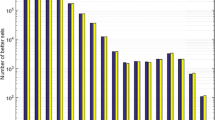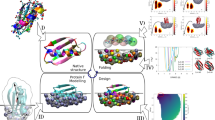Abstract
Early protein synthesis is thought to have involved a reduced amino acid alphabet. What is the minimum number of amino acids that would have been needed to encode complex protein folds similar to those found in nature today? Here we show that a small β-sheet protein, the SH3 domain, can be largely encoded by a five letter amino acid alphabet but not by a three letter alphabet. Furthermore, despite the dramatic changes in sequence, the folding rates of the reduced alphabet proteins are very close to that of the naturally occurring SH3 domain. This finding suggests that despite the vast size of the search space, the rapid folding of biological sequences to their native states is not the result of extensive evolutionary optimization. Instead, the results support the idea that the interactions which stabilize the native state induce a funnel shape to the free energy landscape sufficient to guide the folding polypeptide chain to the proper structure.
This is a preview of subscription content, access via your institution
Access options
Subscribe to this journal
Receive 12 print issues and online access
$189.00 per year
only $15.75 per issue
Buy this article
- Purchase on Springer Link
- Instant access to full article PDF
Prices may be subject to local taxes which are calculated during checkout
Similar content being viewed by others
References
Shang, Z. et al. Design of a “minimAl” homeodomain: the N-terminal arm modulates DMA binding affinity and stabilizes homeodomain structure. Proc. Natl. Acad. Sci. USA 91, 8373–8377 (1994).
Heinz, D.W., Baase, W.A. & Matthews, B.W. Folding and function of a T4 lysozyme containing 10 consecutive alanines illustrates the redundancy of information in an amino acid sequence. Proc. Natl. Acad. Sci. USA 89, 3751–3755 (1992).
Regan, L. & Degrado, W.F. Charcterization of a helical protein designed from first principles. Science 241, 976–978 (1988).
Kamteker, S., Schiffer, J.M., Xiong, H., Babik, J.M. & Hecht, M.H. Protein design by binary patterning of polar and nonpolar amino acid sequences. Science 262, 1680–1685 (1993).
Scott, J.K. & Smith, G.P. Searching for peptide ligands with an epitope library. Science 249, 386–390 (1990).
Gu, H. et al. A phage display system for studying the sequence determinants of protein folding. Prot. Sci. 4, 11108–1117 (1995).
Feng, S., Chen, J.K., Yu, H., Simon, J.A. & Schreiber, S.L. Two binding orientations for peptides to the src SH3 domain: development of a general model for SH3 ligand interactions. Science 266, 1241–1247 (1994).
Davidson, A.R., Lumb, K.J. & Sauer, R.T. Cooperatively folded proteins in random libraries. Nature Struct. Biol. 2, 856–863 (1995).
Lim, W.A. & Richards, F.M. Critical residues in an SH3 domain from Sem-5 suggest a mechanism for proline-rich peptide recognition. Nature Struct. Biol. 1, 221–225 (1994).
Viguera, A.R., Arrondo, J.L.R., Musacchio, A., Saraste, M. & Serrano, L. Characterization of the interaction of natural proline-rich peptides with five different SH3 domains. Biochemistry 33, 10925–10933 (1994).
Baker, D. & Agard, D.A. Kinetics versus thermodynamics in protein folding. Biochemistry 33, 7505–7509 (1994).
Levinthal, C. Are there pathways for protein folding? J. Chim. Phys. 65, 44–45 (1968).
Baker, D., Sohl, J.L. & Agard, D.A. A protein-folding reaction under kinetic control. Nature 356, 263–265 (1992).
Bryngelson, J.D., Onuchic, J.N., Socci, N.D. & Wolynes, P.G. Funnels, pathways, and the energy landscape of protein folding: a synthesis. Prot. Struc. Funct. Genet. 21, 167–195 (1995).
Dill, K.A. & Chan, H.S. From Levinthal to pathways to funnels. Nature Struct. Biol. 4, 10–19 (1997).
Handel, T.M., Williams, S.A. & DeGrado, W.F. Metal ion-dependent modulation of the dynamics of a designed protein. Science 261, 879–885 (1993).
Woese, C. The Genetic Code, Harper & Row, New York (1967).
Crick, F.H.C. The origin of the genetic code. J. Mol. Biol. 38, 367–379 (1968).
Wong, J.T. A co-evolution theory of the genetic code. Proc. Nat. Acad. Sci. USA 72, 1909–1912 (1975).
Reidhaar-Olsen, J.F. et al. Random mutagenesis of protein sequences using oligonucleotide cassettes. Methods Enzymol. 208, 564–586 (1991).
Yu, H. et al. Structural basis for the binding of proline-rich peptides to SH3 domains. Cell 76, 933–945 (1994).
Scalley, M.L. et al. Kinetics of folding of the IgG binding domain of peptostreptoccocal protein L. Biochemistry 36, 3373–3382 (1997).
Chen, J.K., Lane, W.S., Brauer, A., Tanaka, A. & Schreiber, S.L. Biased combinatorial libraries: novel ligands for the SH3 domain of phosphatidylinositol 3-kinase. J. Am. Chem. Soc. 115, 12591–12592 (1993).
Hubbard, S.J. & Thornton, J.M. “NACCESS” computer program, Department of Biochemistry, University College London (1993).
Koyama, S. et al. Structure of the PI3K SH3 domain and analysis of the SH3 family. Cell 72, 945–952 (1993).
Kraulis, P. MOLSCRIPT: a program to produce both detailed and schematic plots of protein structures. J. Appl. Crystallogr. 24, 946–950 (1991).
Bacon, D. & Anderson, W.F. A fast algorithm for rendering space-filling molecule pictures. J. Mol. Graphics 6, 219–220 (1988).
Merritt, E.A. & Murphy, M.E. Raster 3D Version 2.0 A program for photorealistic molecular graphics. Acta Crystallogr. D50, 869–873 (1994).
Author information
Authors and Affiliations
Rights and permissions
About this article
Cite this article
Riddle, D., Santiago, J., Bray-Hall, S. et al. Functional rapidly folding proteins from simplified amino acid sequences. Nat Struct Mol Biol 4, 805–809 (1997). https://doi.org/10.1038/nsb1097-805
Received:
Accepted:
Published:
Issue Date:
DOI: https://doi.org/10.1038/nsb1097-805
This article is cited by
-
An engineered T7 RNA polymerase that produces mRNA free of immunostimulatory byproducts
Nature Biotechnology (2023)
-
Protein design under competing conditions for the availability of amino acids
Scientific Reports (2020)
-
Reconstruction and Characterization of Thermally Stable and Catalytically Active Proteins Comprising an Alphabet of ~ 13 Amino Acids
Journal of Molecular Evolution (2020)
-
Deciphering Molecular Virulence Mechanism of Mycobacterium tuberculosis Dop isopeptidase Based on Its Sequence–Structure–Function Linkage
The Protein Journal (2020)
-
Reduced alphabet of prebiotic amino acids optimally encodes the conformational space of diverse extant protein folds
BMC Evolutionary Biology (2019)



